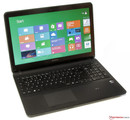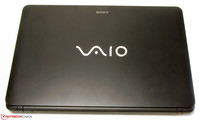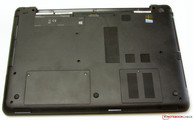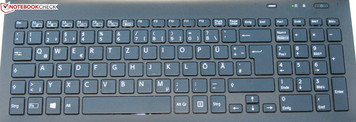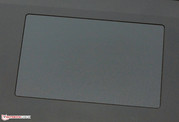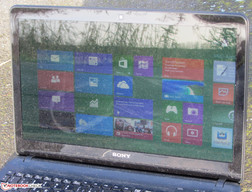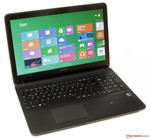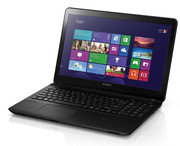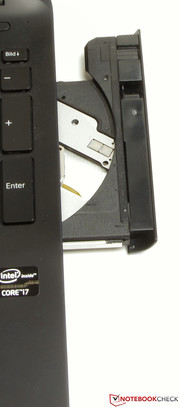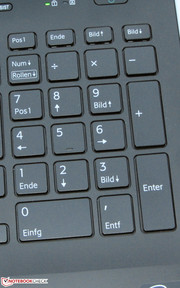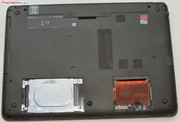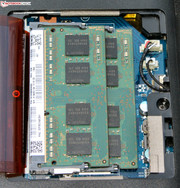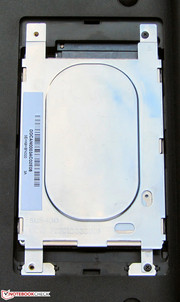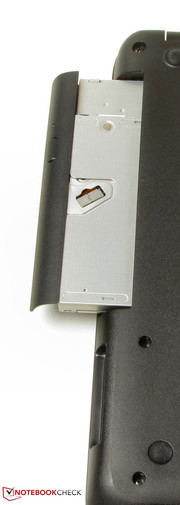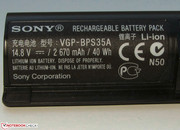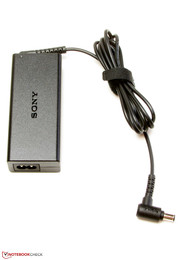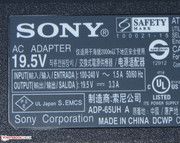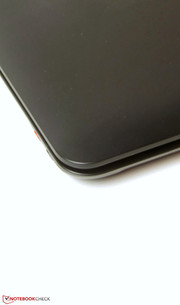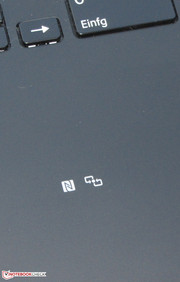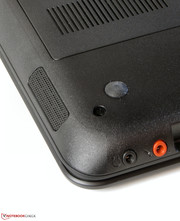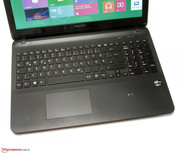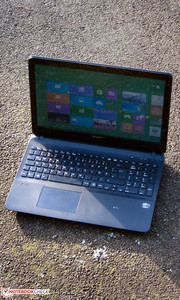Review Sony Vaio Fit SV-F1521V6EB Notebook

For the original German review, see here.
An all-round laptop is expected to cope with most application scenarios, and to look good at the same time. This seems to apply to Sony's laptop at first glance. It offers a lot of storage capacity, a gaming-suitable GPU, and the laptop can even play Blu-ray discs. Our test report exposes whether the Vaio is compelling as a whole.
We used Lenovo's IdeaPad Z510 (Core i5-4200M, GeForce GT 740M) and HP's Pavilion TouchSmart 15-n010sg (Core i7-4500U, GeForce GT 740M) to classify the laptop. The latter device features a touchscreen.
Case
Both the Vaio and the IdeaPad are completely made of plastic. Hewlett Packard uses aluminum parts besides plastic for its Pavilion. Sony's laptop features a matte-black casing. The designers just did not restrain themselves with the display bezel and dug out the gloss varnish.
The base unit makes a rigid impression, but also exhibits a weakness that we often encounter in many laptops: the base unit can be warped slightly on the keyboard's left and right. The stiffness is still acceptable, although the build gives reason for complaint. A cracking noise is produced when we press the upper and underside of the front corner with two fingers. The lid can be twisted too easily, and the back can be pressed to such an extent that image distortions are generated. The hinges keep the lid firmly in position, but wobble a bit. Opening the lid with one hand is possible.
Basically, the casing is overall satisfactory. Nevertheless, we would have expected more from a laptop priced at almost 900 Euros (~$1239). It could have been more robust, and metal components would also be possible in this price range.
Connectivity
All three comparison laptops provide today's standard interfaces. It is good that all three have two USB 3.0 ports, which make speedy data transfer between two external hard drives possible. Neither the Vaio nor the Pavilion sport a VGA out. The user will have to use an HDMI-to-VGA adapter should this interface be needed (price: approx. 20 Euros, ~$27). The Vaio features NFC technology (near-field communication). It allows wireless data sharing between two devices over a short range (a few centimeters). The module is located in the wrist rest's right area. NFC is primarily known for cash-less payments via a smartphone.
The Vaio's interface positioning is unfavorable. The ports are found in the front area on both sides. Also, the ports are submerged into the casing, and thus the plugs should not be too thick because they would not fit otherwise. We, however, did not have any problems; even our HDMI cable with a plug thickness of approximately 12 mm could be inserted.
Communication
The Wi-Fi chip in the Vaio is the BCM43142 from Broadcom, and it supports the Wi-Fi standards 802.11 b/g/n. In addition to Wi-Fi, the module also supplies Bluetooth 4.0. We did not experience any problems with Wi-Fi transmission. Although the signal strength often fluctuated within a radius of approximately 15 meters around the router (2 to 5 bars), we did not notice any interruptions or slower transmission speeds. This is, however, not a standardized test. Realtek's RTL8168/8111 Gigabit Ethernet chip can be used for cabled network connections. The built-in webcam renders a muddy picture in a maximum resolution of 1280x720 pixels.
Accessories
A few printed instructions and a quick-start poster come with the laptop. No additional accessories are included.
Windows 8 (64-bit) is preinstalled as the operating system. An installation DVD is not included, and therefore the laptop buyer should create backup media immediately after purchase. This would, for example, make it possible to reinstall the system after exchanging the hard drive. Sony includes a corresponding tool that is part of the preinstalled Vaio Care software, which is opened via the Assist button. This button also turns on the laptop when pressed in a shut down state, and opens a menu that enables accessing various repair and recovery functions, as well as the BIOS.
It is also possible to swap Windows 8 for Windows 7 when preferred. Sony provides drivers for both Windows 7 and Windows 8 on its website.
Maintenance
Two maintenance covers are found on the Vaio's underside. One cover allows accessing the hard drive, and the other the working memory. The laptop features two working memory banks that are fitted with a 4 GB module each. Replacing the hard drive would not be difficult; 2.5-inch models with a height of either 7 or 9.5 mm can be used.
Warranty
A 24 month warranty is included on the Vaio, like the IdeaPad. Buyers of the Pavilion will have to be satisfied with a one-year standard warranty. The Vaio's warranty can be upgraded to three years for approximately 100 Euros (~$137), or four years for approximately 180 Euros (~$247).
Input Devices
Keyboard
The Vaio features an illuminated chiclet keyboard. The light has three settings: on, off, and on when a key is pressed. There are no function keys to change its state; the Vaio's control center always has to be opened for this. The keys have a size of almost 15 x 15 mm. They supply an overall short drop and clear pressure point. The keys' resistance could be a bit firmer, but that is a matter of taste. The keyboard yields a bit when typing on it, but we did not find that exceedingly annoying. Basically, the keyboard is acceptable for home use.
Touchpad
The Vaio's multi-touch ClickPad, i.e. a touchpad without dedicated keys because the entire pad is a button, has a surface area of 10.5 x 6.5 cm. Thus, there is enough room for using multi-touch gestures comfortably. The different gestures can be individually disabled or enabled in the pad's setup menu. Not all available gestures are enabled by default. The pad's sleek surface allows the fingers to glide over it easily. The pad has a short drop, and a clearly audible and palpable pressure point.
Display
Sony installs a glare-type, 15.5-inch screen that works with a native resolution of 1366x768 pixels. The Pavilion features a virtually identical model. Buyers of the IdeaPad are treated to a matte Full HD screen. The Vaio screen provides an average brightness of 214.2 cd/m², which places it in the upper midfield. The Pavilion's screen is much lower (142.6 cd/m²), while the IdeaPad (294.6 cd/m²) scores much better than both contenders.
| |||||||||||||||||||||||||
Brightness Distribution: 89 %
Center on Battery: 228 cd/m²
Contrast: 713:1 (Black: 0.32 cd/m²)
ΔE ColorChecker Calman: 10.06 | ∀{0.5-29.43 Ø4.78}
ΔE Greyscale Calman: 9.93 | ∀{0.09-98 Ø5}
39.8% AdobeRGB 1998 (Argyll 1.6.3 3D)
43.41% AdobeRGB 1998 (Argyll 3D)
62.4% sRGB (Argyll 3D)
42.02% Display P3 (Argyll 3D)
Gamma: 3.24
CCT: 9831 K
The Vaio screen's contrast of 713:1 and black level of 0.32 cd/m² are both compelling. The same is true for the Pavilion's screen (681:1; 0.21 cd/m²), but the IdeaPad's display is clearly defeated (327:1; 0.97 cd/m²). The screen cannot cover either the AdobeRGB or sRGB color spaces with 39.8% and 55.9% respectively. These color spaces are, for example, important in professional image editing.
The screen's average DeltaE 2000 deviation is 10 in state of delivery. No color achieves the target range of DeltaE smaller than 3. The screen exhibits a bluish cast.
It is quite possible to recognize content on the screen outdoors. However, the laptop has to be placed in a position that prevents reflections.
To put it kindly, the Vaio's viewing angle stability is very poor and equals those from the budget laptop sector. The horizontal angle is sufficiently wide, and allows several people to look at the screen. Changing the vertical viewing angle quickly causes image distortions though. Overall, we would have expected a better screen for a laptop price of just under 900 Euros (~$1239). A marginally higher-quality TN screen would have been the least.
Performance
Sony's Vaio Fit line could be seen as the successor of the former E-series. Sony offers innumerable laptops in a wide range of performance levels within the Fit product line - starting with entry-level models up to all-rounders. Our review sample is a 15.5-inch all-rounder. In addition to routine tasks, the laptop can also be used for playing up-to-date games. Our review sample is currently sold for approximately 800 Euros (~$1101).
Processor
The Vaio is equipped with an Intel Core i7-3537U processor. This dual-core model comes from the former Ivy Bridge generation. It is surprising that Sony did not install a Haswell processor. The Core i7 works with a base clock of 2 GHz. Its speed can be increased to 2.9 GHz (both cores) and 3.1 GHz (one core only) via Turbo. The CPU is a member of the ULV processors that run with a low voltage, which reduces the power consumption. Intel specifies a TDP of 17 watts for the Core i7.
The processor performed the Cinebench CPU tests with a stable 2.9 GHz. Overall, the Vaio's score is slightly lower than that of the Pavilion (Core i7-4500, GeForce GT 740M). The latter benefits from its somewhat stronger Haswell processor. The IdeaPad (Core i5-4200M, GeForce GT 740M) particularly stands out from its contenders in multi-thread applications because the installed processor works with higher Turbo speeds, and a higher base clock. The Pavilion and IdeaPad are on par in single-thread applications. Although all three laptops sport the same GPU, the IdeaPad wins the GL tests. The GPUs in the contenders do not run the tests at full speed.
System Performance
We did not experience any problems with the system performance. The system runs smoothly and without hitches. The PCMark benchmarks scores are correspondingly good. The Vaio lags behind the Pavilion (Core i7-4500U, GeForce GT 740M) slightly because it sports the weaker processor. The IdeaPad (Core i5-4200M, GeForce GT 740M) is far ahead of its contenders, which is due to its stronger processor and the installed hybrid hard drive.
The easiest way to increase the system's performance would be to install a solid state drive. We tried this. Our Crucial RealSSD C300 - 64 GB SSD let Windows boot faster, and the system was overall swifter. The PCMark benchmark scores also increased; the Vaio's PCMark 7 score improved by approximately 69% to 4807 points.
| PCMark Vantage Result | 6970 points | |
| PCMark 7 Score | 2844 points | |
| PCMark 8 Home Score Accelerated | 2948 points | |
| PCMark 8 Creative Score Accelerated | 2804 points | |
| PCMark 8 Work Score Accelerated | 4554 points | |
Help | ||
Storage Device
Sony installs a Travelstar 5K1000 hard drive from HGST. The hard drive has a capacity of 1 TB and spins with 5400 revolutions per minute. CrystalDiskMark recorded a read speed of 99.68 MB/s; HD Tune delivered an average transfer rate of 81.9 MB/s. The rates are acceptable, and correspond to the performance of most modern 5400 rpm hard drives. We were overall satisfied with the hard drive. It offers a lot of storage capacity and works sufficiently fast. Nevertheless, we would have expected a hybrid hard drive or alternatively an SSD cache for the laptop's purchase price.
Graphics Card
The Optimus configuration made up of Intel's HD Graphics 4000 GPU and Nvidia's GeForce GT 740M graphics core is used in the Vaio. The Intel core is enabled in routine and battery operation. The GeForce GPU takes care of performance hungry computer games. Both chips support DirectX 11.1. The GeForce chip is a member of the mid-range. It works with a base speed of 980 MHz, which can be increased to 1058 MHz via Turbo.
All three comparison laptops sport the same GPU. Consequently, their scores in the 3DMark benchmarks should be very similar. However, the IdeaPad (Core i5-4200M, GeForce GT 740M) scores a bit better due to its stronger CPU. The Vaio consistently scores a bit worse than both the Pavilion (Core i7-4500U, GeForce GT 740M) and the IdeaPad. That is due to its slightly weaker CPU.
All three laptops generally do not max out their potential. The graphic chips in all devices are connected to the graphics memory via a 64-bit line, which slows down the graphics cores extremely. They achieve scores that are partly below those of a GeForce GT 730M. Nvidia also offers a GeForce GT 740M that is connected to the graphics memory via a 128-bit interface. A correspondingly equipped laptop would be the Asus N56VB-S4050H (Core i7-3630QM, GeForce GT 740M). This laptop achieves roughly 30% better 3DMark scores.
| 3DMark 06 Standard Score | 9266 points | |
| 3DMark Vantage P Result | 6073 points | |
| 3DMark 11 Performance | 1888 points | |
| 3DMark Ice Storm Standard Score | 52119 points | |
| 3DMark Cloud Gate Standard Score | 5352 points | |
| 3DMark Fire Strike Score | 1059 points | |
Help | ||
| Sony Vaio SV-F1521V6EB GeForce GT 740M, 3537U, HGST Travelstar 5K1000 HTS541010A9E680 | HP Pavilion TouchSmart 15-n010sg GeForce GT 740M, 4500U, Seagate Momentus Thin ST500LT0 12-9WS142 | Lenovo IdeaPad Z510 GeForce GT 740M, 4200M, Seagate ST500LM000 Solid State Hybrid Drive | Asus N56VB-S4050H GeForce GT 740M, 3630QM, WDC Scorpio Blue WD7500BPVT-80HXZT3 | |
|---|---|---|---|---|
| 3DMark | 3% | 3% | 35% | |
| 1280x720 Ice Storm Standard Score (Points) | 52119 | 55133 6% | 52373 0% | 67664 30% |
| 1280x720 Cloud Gate Standard Score (Points) | 5352 | 5466 2% | 5375 0% | 8226 54% |
| 1920x1080 Fire Strike Score (Points) | 1059 | 1065 1% | 1147 8% | 1269 20% |
Gaming Performance
The CPU/GPU combination of the Vaio ensures that most games can be played smoothly in the native resolution of 1366x768 pixels in medium quality settings. Our three comparison laptops achieve fairly identical frame rates. Again, the IdeaPad has a slight lead because it sports the strongest processor. Like in the 3DMark benchmarks, the three laptops remain behind their possibilities due to their graphics memory only connected via a 64-bit interface. A direct comparison with the Asus N56VB-S4050H proves this.
Other laptops are available should more focus be placed on gaming. For example, the aforementioned Asus N56VB. It is within the same price range of the other laptops. A much stronger device would be the Lenovo IdeaPad Y510p. It features a Core i7-4700MQ processor, and a GeForce GT 755M SLI array (= 2 graphics cards). The laptop is sold for approximately 1050 Euros (~$1445) with a matte Full HD screen. A slimmed down version with a Core i5-4200M and only one GeForce GT 755M core is available from 750 Euros (~$1032). It also features a matte Full HD screen, but does not include a Windows operating system.
| low | med. | high | ultra | |
|---|---|---|---|---|
| Anno 2070 (2011) | 94.6 | 53.4 | 28.8 | |
| Tomb Raider (2013) | 88.8 | 42.9 | 23.9 | |
| GRID 2 (2013) | 121 | 71.4 | 44.9 |
| Sony Vaio SV-F1521V6EB GeForce GT 740M, 3537U, HGST Travelstar 5K1000 HTS541010A9E680 | HP Pavilion TouchSmart 15-n010sg GeForce GT 740M, 4500U, Seagate Momentus Thin ST500LT0 12-9WS142 | Lenovo IdeaPad Z510 GeForce GT 740M, 4200M, Seagate ST500LM000 Solid State Hybrid Drive | Asus N56VB-S4050H GeForce GT 740M, 3630QM, WDC Scorpio Blue WD7500BPVT-80HXZT3 | Lenovo IdeaPad Y510p-59400120 GeForce GT 755M SLI, 4700MQ, Seagate ST1000LM014 Solid State Hybrid Drive | |
|---|---|---|---|---|---|
| Tomb Raider | -0% | 9% | 36% | 348% | |
| 1024x768 Low Preset (fps) | 88.8 | 87.5 -1% | 97 9% | 111.4 25% | |
| 1366x768 Normal Preset AA:FX AF:4x (fps) | 42.9 | 42.7 0% | 47 10% | 57.9 35% | 164.6 284% |
| 1366x768 High Preset AA:FX AF:8x (fps) | 23.9 | 23.9 0% | 25.9 8% | 35.3 48% | 122.1 411% |
Emissions
System Noise
We measured a noise level ranging from 30.3 to 31.9 dB in idle mode. These rates are acceptable in view of the laptop's available performance. The IdeaPad (30.9 to 32.4 dB) and the Pavilion (31.7 to 32.7 dB) are roughly on par with that. The Vaio's noise increased to 38.5 dB during medium load (via 3DMark06) and 40.1 dB in full load (stress test via Prime95 and Furmark). Thus, it places itself between the IdeaPad (37.6 and 39.1 dB) and the Pavilion (42.8 and 45.9 dB). We should mention the Vaio's quiet Blu-ray drive from which we ascertained a maximum noise level of 32.7 dB.
Noise level
| Idle |
| 30.3 / 30.3 / 31.4 dB(A) |
| HDD |
| 31.9 dB(A) |
| DVD |
| 32.7 / dB(A) |
| Load |
| 38.5 / 40.1 dB(A) |
 | ||
30 dB silent 40 dB(A) audible 50 dB(A) loud |
||
min: | ||
Temperature
While idling, the surface temperatures of all three laptops are within an acceptable range. The TouchSmart's temperatures all clearly remain below 30 °C. The devices all surpass 40 °C in several areas, but that is tolerable.
The CPU ran the stress test (Prime95 and Furmark run for at least one hour) with 2 GHz in both AC and battery mode. Speeds of 2.7 to 2.8 GHz were only reached in the first 4 to 5 minutes. However, the GPU always worked at full Turbo speed (1058 MHz), regardless whether on AC or battery power. We reran 3DMark06 directly after the stress test. The score was identical with that in the laptop's cold state. The CPU's temperature settled to approximately 67 °C in AC mode.
(±) The maximum temperature on the upper side is 44 °C / 111 F, compared to the average of 36.9 °C / 98 F, ranging from 21.1 to 71 °C for the class Multimedia.
(±) The bottom heats up to a maximum of 42.7 °C / 109 F, compared to the average of 39.2 °C / 103 F
(+) In idle usage, the average temperature for the upper side is 28.3 °C / 83 F, compared to the device average of 31.3 °C / 88 F.
(+) The palmrests and touchpad are reaching skin temperature as a maximum (33.2 °C / 91.8 F) and are therefore not hot.
(-) The average temperature of the palmrest area of similar devices was 28.7 °C / 83.7 F (-4.5 °C / -8.1 F).
Speakers
The Vaio's stereo speakers are on the front. They produce a pleasant, rich sound that lacks bass. Speech is well-intelligible. Headphones or external speakers would be recommendable for a higher-quality sound experience.
Energy Management
Power Consumption
The Vaio consumes between 6.5 and 11.4 watts when idling. This makes it evident that an Ivy Bridge ULV processor is still used in the laptop. The Pavilion (4 to 7.4 watts) sports a Haswell ULV CPU, and is more energy-efficient. Even the IdeaPad's power consumption is marginally lower, despite a standard mobile processor (Haswell). The Vaio's power consumption increases to 39.2 watts during medium load (via 3DMark06) and 45.6 watts in full load (stress test via Prime95 and Furmark). Thus, it is roughly on par with the Pavilion (42.3 and 42.5 watts). The IdeaPad consumes the most power (57.9 and 55.4 watts) due to its standard mobile processor. The full load rate is lower because the laptop does not run at full speed.
| Off / Standby | |
| Idle | |
| Load |
|
Key:
min: | |
Battery Runtime
The Vaio's battery lasted for 5:45 h in idle mode. The IdeaPad (6:56 h), and particularly the Pavilion (8:06 h) achieve better runtimes. The idle mode is ascertained with Battery Eater's Reader's test, where the screen is set to minimum, the energy-savings profile is enabled, and the wireless modules are off. Sony's laptop shut down after 1:17 h of load. The IdeaPad (1:29 h) and the Pavilion (1:26 h) only last a bit longer. The load runtime is ascertained via Battery Eater's Classic test using maximum screen brightness, the high-performance profile, and enabled wireless modules.
The Vaio closed the Wi-Fi test after 4:08 h. Thus, it is positioned between the IdeaPad (3:27 h) and the Pavilion (4:26 h). Websites are automatically opened every 40 seconds, the energy-savings profile is active, and the screen's brightness is set to approximately 150 cd/m² for this test. DVD playback stopped after 2:39 h on the Vaio. The IdeaPad (2:43 h) is on a par, and the Pavilion (3:33 h) again presents the longest runtime. The DVD test is performed using enabled energy-savings profile (or a higher profile should the DVD not run smoothly), maximum screen brightness, and disabled wireless modules.
The runtimes of the three devices can be compared quite well because their battery capacities (Sony: 40 Wh; Lenovo: 48 Wh; HP: 41 Wh) are quite similar.
Verdict
Sony's Vaio Fit SVF1521V6EB offers a decent application and gaming performance. The computer provides a high storage capacity, and can boast with a Blu-ray burner. That also summarizes the laptop's advantages. The Vaio's purchase price is just under 900 Euros (~$1239), which is too high in our opinion. Sony should have delivered more to justify this price. A better screen with Full HD resolution, a hybrid hard drive, a higher-quality casing, and better battery runtimes: just to name a few examples. It is also inconceivable that Sony still uses an Ivy Bridge processor.
Lenovo's IdeaPad Z510 is interesting for users who want maximum performance. Of the three comparison devices, it achieves the best rates in our benchmarks. Another highlight of the Z510 is its matte Full HD screen. The laptop is available for 700 Euros (~$963), and makes the IdeaPad the lowest priced laptop among our comparison devices. HP's Pavilion TouchSmart 15-n010sg comes into question when the longest possible runtimes are needed. The HP laptop is priced at around 800 Euros (~$1101). Another alternative for the gaming segment would be the Asus N56VB because it achieves much higher frame rates than the other three laptops. Its price is approximately 800 Euros (~$1101) with a Core i5 processor or 900 Euros (~$1239) with a Core i7 processor.




